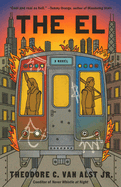
 Theodore C. Van Alst Jr. (Sacred Smokes; Sacred City) offers a love letter to the city of Chicago via a single-day odyssey in The El, an expansive novel featuring young gang members on a circular journey through an urban landscape. With strong imagery, dreamlike sequences, and gritty considerations of family, love, spicy potato chips, and gun violence, this unusual story will capture and hold the imagination.
Theodore C. Van Alst Jr. (Sacred Smokes; Sacred City) offers a love letter to the city of Chicago via a single-day odyssey in The El, an expansive novel featuring young gang members on a circular journey through an urban landscape. With strong imagery, dreamlike sequences, and gritty considerations of family, love, spicy potato chips, and gun violence, this unusual story will capture and hold the imagination.
On an August day in 1979, teenaged Teddy wakes up early, eats a few buttered tortillas, and gets ready for a momentous event. He will lead 18 fellow members of the Simon City Royals across town via Chicago's elevated train (the El) to a meeting with another "set" of the gang and many others, where a new alliance formed in prison would be applied on the outside. The new Nation will include old enemies, but Teddy is a team player. It is a day of high stakes, and while they all share trepidations, not everyone shares Teddy's hopeful outlook. "Jesus, Coyote, Al Capone... I was sure all of us prayed to them equally."
Teddy narrates as he sets out with his best friend, Mikey. Then the perspective switches to Mikey's. Teddy remains the protagonist and most common narrator, but a broad variety of players cycle through, providing different angles on the potential impacts of the Nation alliance as well on as the scenes themselves: a fire on an El platform, an attempted murder, various deaths, moments of beauty. Teddy's Native identity matters because race is a question for the new Nation, spoken of but not exactly on the official agenda. Teddy can see a character he knows to be Coyote, "walnut brown and wiry, wearing a pair of mirrored Aviators," who "tends to hum in and out of focus." This character, or force, plays an important role in the day.
The El is utterly intriguing at every turn, shifting pace from high-drama action scenes to contemplative minutes and hours spent rocking in rhythm with public transit and the city itself. Van Alst portrays a strong sense of both time and place as his characters grapple with race, class, and culture in a very particular big city. The novel is about cusps: of the season, the turning of the decade, the gangs' political shifts, the move away from "skins-only" violence and toward more guns, and comings of age. Van Alst gives us tragedy as well as beauty, and a sharp, loving portrait of a place, with Teddy "riding all the way back toward the neighborhood, window wide open, warm wind howling in, and me in love with everything we could ever be." --Julia Kastner, blogger at pagesofjulia
Shelf Talker: Young gang members in 1979 Chicago take public transportation across the city on a single, important day in this shape-shifting, kaleidoscopic novel of big risks and dreams.

